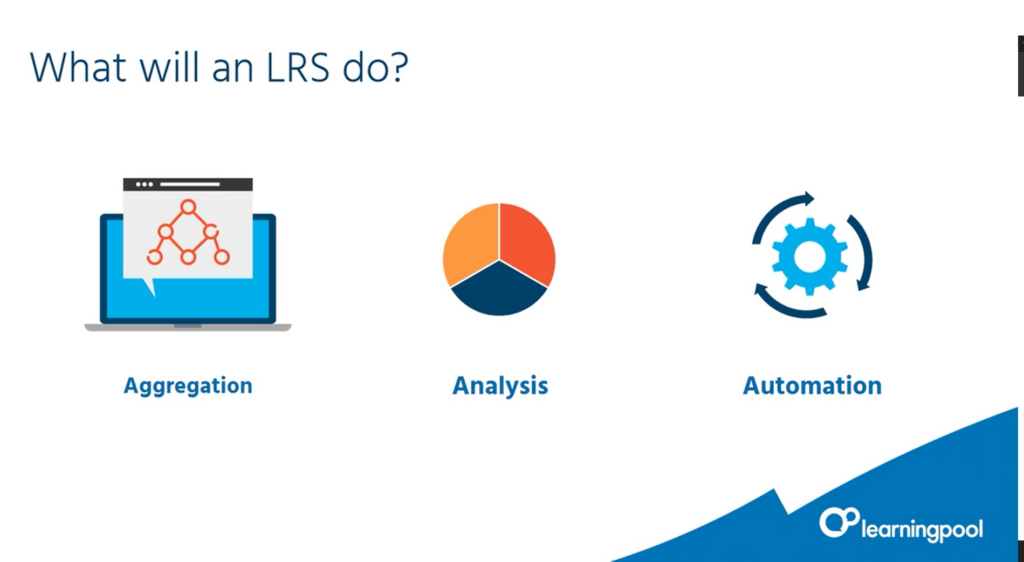In the age of computing, data has slowly but surely taken over the world. In Data, Learning and the LRS: Challenging Trends, learningpool COO Deborah Limb, HT2Labs CEO and founder Ben Betts explore:
-
The history of data use in learning
-
What kind of data could we be collecting?
-
How could better data serve your L&D needs?
-
New possibilities of data collection
-
The role of the Learning Records Store
But what about learning data? SCORM 1.2 has been the de-facto tracking standard in eLearning for as long as many of us have been in the industry. Data is one area of learning technology that has huge potential to change the industry for good.
The third webinar in this series is split into three sections covering the intelligence revolution, the potential of aggregation, analysis and automation, and where to start.
The intelligence revolution
The period we find ourselves in is being referred to as the intelligence revolution, building on what computing has taught us. The intelligence revolution is an era of the intelligent use of data, and the mix of biological and artificial interfaces that we are surrounded by.
This topic covers the level of maturity of learning data collection within different organisations
Key topics for this year have been personalised learning, AI and analytics, which are all driven by data, so this is a really hot topic.
The potential of aggregation, analysis and automation
This section covers the function of a Learning Record Store (LRS), how it focuses specifically on learning data and how it can best service L&D professionals. The panel discuss how an LRS differs from a Learning Management System (LMS) and the three As that comprise it:
Aggregation: How can we collect data into a single source of record?
Analysis: How can we then analyse that to understand what the data is telling us?
Automation: And then how can we then use that understanding and insight to automate more good practice?
LRS is about how to aggregate, analyse and automate data to be more meaningful, and is part of the journey to becoming more proactive in affecting learning and performance outcomes before they occur.
Each of these three elements is covered in detail, explaining how to address each of them, in order to pull together a working LRS.
Where to start
Most organisations start relatively small with LRS, thinking about some of the basic pain points.
Limb and Betts scratch at the surface, share some case studies and talk about where to get started, such as
-
Reporting areas causing difficulties
-
Methods to understand impact
-
Metrics to evaluate effectiveness
-
Who else in the business do you need to co-op for eg a performance metric?
To watch the Data, Learning and the LRS webinar 3 on-demand, download it here via learningpool.
In the age of computing, data has slowly but surely taken over the world. In Data, Learning and the LRS: Challenging Trends, learningpool COO Deborah Limb, HT2Labs CEO and founder Ben Betts explore:
The history of data use in learning
What kind of data could we be collecting?
How could better data serve your L&D needs?
New possibilities of data collection
The role of the Learning Records Store
But what about learning data? SCORM 1.2 has been the de-facto tracking standard in eLearning for as long as many of us have been in the industry. Data is one area of learning technology that has huge potential to change the industry for good.
The third webinar in this series is split into three sections covering the intelligence revolution, the potential of aggregation, analysis and automation, and where to start.
The intelligence revolution
The period we find ourselves in is being referred to as the intelligence revolution, building on what computing has taught us. The intelligence revolution is an era of the intelligent use of data, and the mix of biological and artificial interfaces that we are surrounded by.
This topic covers the level of maturity of learning data collection within different organisations
Key topics for this year have been personalised learning, AI and analytics, which are all driven by data, so this is a really hot topic.
The potential of aggregation, analysis and automation
This section covers the function of a Learning Record Store (LRS), how it focuses specifically on learning data and how it can best service L&D professionals. The panel discuss how an LRS differs from a Learning Management System (LMS) and the three As that comprise it:
Aggregation: How can we collect data into a single source of record?
Analysis: How can we then analyse that to understand what the data is telling us?
Automation: And then how can we then use that understanding and insight to automate more good practice?
LRS is about how to aggregate, analyse and automate data to be more meaningful, and is part of the journey to becoming more proactive in affecting learning and performance outcomes before they occur.
Each of these three elements is covered in detail, explaining how to address each of them, in order to pull together a working LRS.
Where to start
Most organisations start relatively small with LRS, thinking about some of the basic pain points.
Limb and Betts scratch at the surface, share some case studies and talk about where to get started, such as
Reporting areas causing difficulties
Methods to understand impact
Metrics to evaluate effectiveness
Who else in the business do you need to co-op for eg a performance metric?





